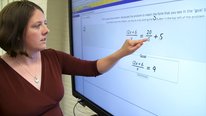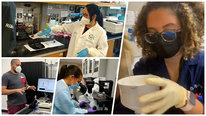- Ivon Arroyo
- https://www.wpi.edu/people/faculty/iarroyo
- Assistant Professor
- Presenter’s NSFRESOURCECENTERS
- Worcester Polytechnic Institute
- Erin Ottmar
- https://sites.google.com/site/erinottmar/
- Assistant Professor of Learning Sciences and Technology
- Presenter’s NSFRESOURCECENTERS
- Worcester Polytechnic Institute
Teaching Computational Thinking through Programming Wearable Devices as Finit...
NSF Awards: 1647023
2017 (see original presentation & discussion)
Grades K-6, Grades 6-8, Grades 9-12
This video will demonstrate our NSF funded project that uses cell phone technology and SmartWatches to train middle school students in public schools in computational thinking and mathematics, by having children create such augmented reality games with math related challenges. This new genre of embodied technologies (mobile and wearable devices that involve motion and physical activity) will allow children to create augmented reality math games as well as play each other's math games. The project intends to advance scientific knowledge on how people learn, as it investigates how to teach mathematics and computing through game play and game design. It investigates how K-12 students may program mobile and wearable technologies (SmartWatches and cell phones) as finite-state-machines, a topic that is typically reserved for undergraduates in Computer Science. The project goes beyond the idea of playing embodied games to having students become creators of math games. In this process, students shift their perspective from consumers to producers, thinking about what is beneath and beyond the surface of what they can immediately see and perceive, thinking at higher levels of abstraction.
This video will introduce the idea of teaching finite-state-machines to K-12 students using engaging, high-quality embodied technologies in the form of wearable electronics, while teaching K-12 mathematics through game play and game design. Iterative design studies will examine the feasibility of the approach, including attention to the associated professional development needs for teachers, the human-computer interaction questions raised by programmable wearables, the finite state machine metaphor for learner-oriented programming environments, and curricular constraints and affordances of embedding the work in math learning.
Related Content for Teaching Computational Thinking through Wearable Devices
-
 2021Wearable Learning Cloud Platform (WLCP)
2021Wearable Learning Cloud Platform (WLCP)
IVON ARROYO
-
 2020Developing Computational Thinking through Game Design & Play
2020Developing Computational Thinking through Game Design & Play
Ivon Arroyo
-
 2020Graspable Math: A Dynamic Tool for Algebraic Understanding
2020Graspable Math: A Dynamic Tool for Algebraic Understanding
Erin Ottmar
-
 2020E-Rebuild: Scalable Architectural Game for Math Learning
2020E-Rebuild: Scalable Architectural Game for Math Learning
Fengfeng Ke
-
 2022University of Puerto training the next generation scientists
2022University of Puerto training the next generation scientists
Carlos Malca Reyes
-
 2015Math Snacks
2015Math Snacks
Barbara Chamberlin
-
 2021STEAM Education and Outreach during COVID19 Pandemia
2021STEAM Education and Outreach during COVID19 Pandemia
Liz Diaz
-
 2022Studying Mathematical Teacher Noticing with 360 Video
2022Studying Mathematical Teacher Noticing with 360 Video
Karl Kosko


Jodi Asbell-Clarke
hi - thanks for the interesting video and project. I am wondering about the facets of CT that you present to the teachers and students? How do you link their game design to CT facets (e.g. problem decomposition or abstraction)? thanks!
Vivian Guilfoy
Very interesting project, especially combining physical environment, movement, and devices. The notion of having high school students create games for middle school students....and eventually middle school students creating games for elementary students is a great feature of your efforts. Have you done any research to discover particular aspects of CT that are particularly enhanced by your efforts? What are they?
Ivon Arroyo
Assistant Professor
Dear Vivian, thanks for your comment!
Something that we know so far, given our last study, is that high school students learn about state-machines and how to plan and specify the behavior of the mobile devices as finite state machines, something they did not know at all before starting.
Erin Ottmar
Assistant Professor of Learning Sciences and Technology
Hi Jodi and Vivian! Thanks for your comments. Your questions are exactly the direction that this project is headed. We are in the early stages of this project and have found that high school students are able to successfully conceptualize and create games and begin to develop an understanding of both the front end and back end of what is required to create games with technology. As a part of this project, we had students create visual representations of these games, and then had them adapt those representations after learning about state-based diagrams. We are currently developing a coding system and measures to better understand which parts of game design and CT were enhanced and where gaps still remain. We hope that the coding and analysis work that we do this summer will point us in the right direction to understanding your questions more specifically.
Natalya St. Clair
Erin, thanks for this video and project! I was wondering if you plan to look at how students learn with data and working with CSV/data exports from student games, too.
Erin Ottmar
Assistant Professor of Learning Sciences and Technology
Hi Natalya- Our goal is to understand how developing and playing games alters students computational thinking. However, the log data from student use could be used by others to explore data patterns. We are doing this in some of our other work (see our videos on graspable math and sonification) but havent explored it in this study.
Marion Usselman
In what types of classes are you implementing your program? Are the high school students in a computer science or digital technology class? Or is this extracurricular? How about the middle school students?
Heather Kim
HI, very interesting project! I can see how exciting this kind of work would be exciting for students. Can you describe a bit of the professional development teachers receive to help them implement this? Great video!
Erin Ottmar
Assistant Professor of Learning Sciences and Technology
Thanks Heather! We have yet to develop the specific PD for this project as its in the early stages. However, our idea is that teachers tjemselves are players and creators. By engaging in the exact process that their students will engage, they will be better positioned to anticipate and understand challenges, processes, and problem solving approaches specific to this activity. This is one of our next steps (with middle school teachers) to see if they themselves can create games and also experience the role of being a player.
Martin Storksdieck
Director and Professor
What an interesting project; I can easily see that the kids can be quite involved. I have two questions: 1) What is your working definition for "computational thinking"? I am asking because I wonder which aspects of this concept is being activated by what kind of students when working with an easy-to-use game engine (and how you would know). The second question is about your collaborator on the Philippines: are you doing this in both locations and if so, what differences, if any, do you note?
Erin Ottmar
Assistant Professor of Learning Sciences and Technology
Hi Martin
At this point, we are focusing more of the problem solving aspects of CT within the context of finite state machines. we are beginning to explore measures to help us operationalize CT within the context of a game engine.
We have had much success in the Phillipines and are planning on rerunning the study in US schools this fall. Its an empirical question whether or not there are cross-cultural differences or similarities and this is something we are excited to find out!
Bernadette Sibuma
I like how you have older students designing games for younger students!
Can you elaborate on how you assess students' learning of computational thinking concepts?
Ivon Arroyo
Assistant Professor
Many thanks Martin and Bernadette!
We have been working with Jeannette Wing's definition of computational thinking
Wing, J.M.(2006) Computational thinking. Communications of the ACM. 49(3): 33-35.
(https://www.cs.cmu.edu/~15110-s13/Wing06-ct.pdf)
We are considering computational thinking from a very broad perspective. Students may express their computational thinking in a variety of ways: as rules, as constraints, as conditions (if-then). However, there are more aspects we are considering such as analyzing the general product/solution/game as a whole, concurrency aspects that are important in a multiplayer game, how much they can distinguish between the game itself and the devices as supports to each of the players.
However, Something very unique about this project (and not said in the video) is the way in which we ask students to specify games as FINITE STATE MACHINES. This means that we showed students how a state machine is specified, as actions and reactions, states and transitions between states, and asked them to specify the behavior of mobile devices as such state transition diagrams. We are measuring their computational thinking also as their ability to accurately specify these diagrams, and analyzing where they might stumble, and how the authoring tool might be able to assist them.
Last, note that because this is an exploratory project, one of the important outcomes will be new constructs. We are still analyzing students' productions to define the "computational thinking" construct better. Stay in the loop for future research articles!
IVON ARROYO
Bernadette Sibuma
This is very helpful - thank you for clarifying, Ivon! I would love to hear about any research articles you generate from this work.
Martin Storksdieck
Director and Professor
Yes, very helpful. Also good to know that it is exploratory, and that you are working on developing the concepts of CT more. This makes me wonder even more about the cultural differences between the US and the Philippines...
Erika Scheffler
I think this is a really great concept for many reasons. I really enjoy the idea of having math games that expose students to computational thinking ideas through games associated with action and motion. Many times it can be hard getting students engaged and interested in math, especially when it comes to computation and this is a great way to peak the interest. It allow students to see different aspects of STEM and coming together through math and technology. These wearable games offer a fun outlet for students to practice math. I also really enjoy how you have the older students designing games for the younger ones because it supports learning on both ends. Great video!
Brittany Adams
This is a really interesting concept! I love how students are up and moving around, keeping them engaged in the activity. Having the older students create games for the younger students is also a great idea because it encourages learning across multiple schools, getting the students involved with their peers. Do you anticipate making the application you used to create the games available for public use or do you play on keeping it more localized?
Erin Ottmar
Assistant Professor of Learning Sciences and Technology
Our hope is that with some more time and testing, we can make it available for public use (where they could download the app and then also download the resources and instructions about how to make the materials).
Jackie DeLisi
Research Scientist
I love the idea of students developing their computational thinking while creating games for each other. In the beginning of your video you mention that students are often passive learners in their mathematics classrooms. This made me wonder what you needed to do to support teachers use of your games in their classrooms? Have you seen any differences in what teachers do as a result of using your tools with their students?
Erin Ottmar
Assistant Professor of Learning Sciences and Technology
At this point, we (the researchers) have been the facilitators but we are currently working through thinking about the format measures and structure of PDs to work with teachers to see how this can facilitate teacher change.
Maureen Holden
I love how students are on the move! the concept of creating games for younger students is very motivating for all ages.
Erin Ottmar
Assistant Professor of Learning Sciences and Technology
thanks Maureen!
Further posting is closed as the event has ended.